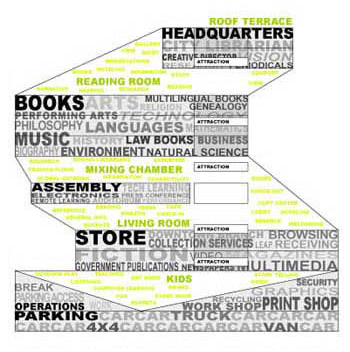Responsible Form Making: Designing the Shapes of Countless Lives Without Being a Total Asshole About It
Curtis B Wayne and I discussed why so much of contemporary architecture neglects the users of the structures on his show, Burning Down the House.
I have a few more things to say about this.
EGO BOXES
Architects have their own language that nobody else understands. Aside from using an obtuse vocabulary to make themselves sound smart, they also communicate in building morphologies.
 The architect whose first move is form generation -- the form being the part of the building you
see when you open up an architecture magazine -- is sending a particular message, a signal, to
other architects.
The architect whose first move is form generation -- the form being the part of the building you
see when you open up an architecture magazine -- is sending a particular message, a signal, to
other architects.
Like the male tit bird that marks its territory in song, the form-first architect demonstrates his (or her!) aesthetic aptitude, fiduciary responsibility to the client (or not), community awareness (or not), fluency in the latest technology, fluency in historical reference (or probably not), and, of course, ego.
Also like the male tit bird, if they want to lay the most fecund client, the form-first architect
must compete with the other tit birds architects by promising to erect the biggest,
most elaborate building morphology. (Fecund clients expect no less because they have been offered
no more.)
When architects play the game of morphology oneupmanship, what's also happening is that the part of the building that people will actually use is given secondary consideration and must be adapted to the arbitrary shape of the architect's ego box.
 Unfortunately, the places of people's lives usually do not so fit well inside of ego boxes.
Oopsies. Sucks to be you.
Unfortunately, the places of people's lives usually do not so fit well inside of ego boxes.
Oopsies. Sucks to be you.
This 4-F architecture (Form first! Fuck function!) raises many questions, questions like:
"What the fuck is that supposed to be?"and
"Do architects hate people?"and
"That's the ugliest piece of shit I've ever seen." (Not actually a question.)
But the question I want to try to answer here is "How did we arrive at this 4-F phenomenon in the first place?"
DIAGRAMS
I want to talk about the Seattle Public Library, because, when you know the story of how Koolhaas generated the form, it almost seems like he started with program -- the part of the building that people use. This makes it seem as though the shape of the building is a natural consequence of the program, which would be ideal. But...this isn't what happened. He started with a diagram of the program. The shape of the building is the shape of the diagram.
 When you look at the diagram you see that he grouped categories of books together and drew
rectangles around those categories (because books are rectangular?). He categorized uses together
and mixed those up with the rectangles and then used diagonal lines (because we move in diagonal
lines?) to connect the rectangles, and there you go. That's the shape of the Seattle Public
Library.
When you look at the diagram you see that he grouped categories of books together and drew
rectangles around those categories (because books are rectangular?). He categorized uses together
and mixed those up with the rectangles and then used diagonal lines (because we move in diagonal
lines?) to connect the rectangles, and there you go. That's the shape of the Seattle Public
Library.
I'm sorry, but...what does this have to do with anything?
Can you imagine designing a living room this way? Can you imagine charting the different types of TV shows you watch in your living room, drawing an outline of your chart, and there you go, that's the shape of your living room! Fun!
What if you categorized all of your kitchen appliances into a diagram, and there you go, that's what shape your kitchen is going to be! Shoot me!
A diagram bears no relationship to the needs of the people who will be using the space. Diagramming as a method of form generation doesn't make sense.
I bring this up because this diagram method is exactly what we were taught at Harvard's Graduate School of Design. The starting point for every project was the diagram. There was hell to pay with your critic if you couldn't produce a diagram and demonstrate a linear progression from your diagram to your final design. A spatial thinker might rue the day that she signed up for Harvard's mind fuck school...or at least rue trying to become an architect in the Age of Deconstructionism. God forbid you thought about what people using the space might find useful and delightful. God forbid you base your design around that. The critics would call you a bad word.
They would tell you that you were being arbitrary.
The fact that the diagram itself is arbitrary is considered acceptable. They posit that yes, you start with something arbitrary, but after that, your process must be rigorous.
Uhhhh...What?
Diagrams didn't make sense to me then, and they don't make sense to me now. And I cannot say, despite the insistence on their use, that anyone found the diagram to be a satisfying design method.
"Drawing plans always make me realize how ridiculous these spaces are." -- Jess
"My interior is ridiculous. I would never want to be in this space." -- Jeremy
The first time I heard this sentiment, it gave me pause. When I kept hearing it from different people, I asked myself, What is it exactly that we're doing here? and I thought Harvard was supposed to be a smart people school, but this seems really retarded. and Why is a 400-year-old school not showing us the wisdom of the ages?
Klaus Herdeg published a book through the MIT Press called The Decorated Diagram: Harvard Architecture and the Failure of the
Bauhaus Legacy. The author's major criticism of the GSD is this preoccupation with
making a nothing program on the inside while making a merely "visually interesting" exterior.
Herdeg was close. We started with the "visually interesting" exterior and then tried to work a miracle to make the inside work too. Good fucking luck with that.
OVERCOMPENSATION
When I see the ridiculous façads of the 4-F architects, I think of those men who drive enormous all-terrain trucks in suburbia, and I ask myself, "What is it that architects are compensating for?"
I have a hypothesis.
There is another way to design...a method of integrated design that hosts happy lives for its users. Christopher Alexander describes this in his many books. It is the distillation of years of research in cultures all over the world. In lieu of a high-priced, high-stress, diagram-based architectural "education," you can hold in your hand a handbook of how to make an architecture of firmness, commodity, and delight.
When you know this way of building, you know something profound. You don't have to trip over yourself to make this year's most stupid building because, instead, you have the power to create a building that really means something for the people who live and work there.
They don't teach you the first thing about this method of design in the architecture schools. Instead of looking to past millennia and untold societies to see what has worked so well for any particular set of user needs, architects are trained to reinvent the wheel each time. And as their own personal god of their projects, 4-F architects tend to create in their own image. And they ain't so pretty.
It must be a real blow to the 4-F architect's ego to hear the backlash. Gehry's Disney Music Hall produced a blinding glare for motorists and its shiny-ness had to be sand blasted off. Zaha's Maxxi fails to fulfill its program. Thom Mayne’s San Francisco Federal Building's most-used room is a windowless bureaucratic holding pen. But...but...at least it's LEED! (Well...kinda.)
"[That] the architect spends tax dollars on his vision is [a] corruption of the public trust." -- Anonymous
"[A]rchitects need to live in the buildings they design to see what it's really like for people who have to work or live in them." -- Anonymous
"Thank you for (finally) doing a review from the users perspective. In my experience, architects stopped thinking about how people using the building react and interact with the design. Instead, form, newness, "coolness", and LEED have taken precedence over people. Design IS people. The architecture community seems to have forgotten that." -- Anonymous
"[A]ll you architects are so full of yourselves and your opinions, "I'm going to get on the interwebz and use large words like "juxtaposition" in order to feed my ego and hopefully hide my self-loathing nature and inability to be anything more than just a bystander giving my useless opinions." Thom Mayne got this building built because he is good at business and good with people. Your design abilities mean nothing unless you can convince someone with money to build it. If I could convince someone to give me 300 million dollars I would build the most hideous building and call it art just because I could." -- Anonymous
But...when the 4-F diagram method of design is all you know, the only way you were taught in school, the way that everyone you know designs...
What can the 4-F architect possibly do to ease the haunting realization that their buildings kinda suck?
Slap more "visual interest" on their next building! Compensate! Compensate! Compensate!
 Do us all a favor and buy this:
Do us all a favor and buy this:
+ Did you enjoy this?
1. Like Architecture Addiction and you'll receive notifications on Facebook when there's something new on the site.
* Some browsers don't show the Facebook Like Box -- and no one seems to know why! If you don't see our Facebook Like Box, you can use this link to visit Architecture Addiction on Facebook.
2. Donate a book to the Architecture Addiction Library
3. Support this site. People typically give $12. You help make Architecture Addiction possible. Thank you for your support!
4. And tell me what you think... I really want to know!